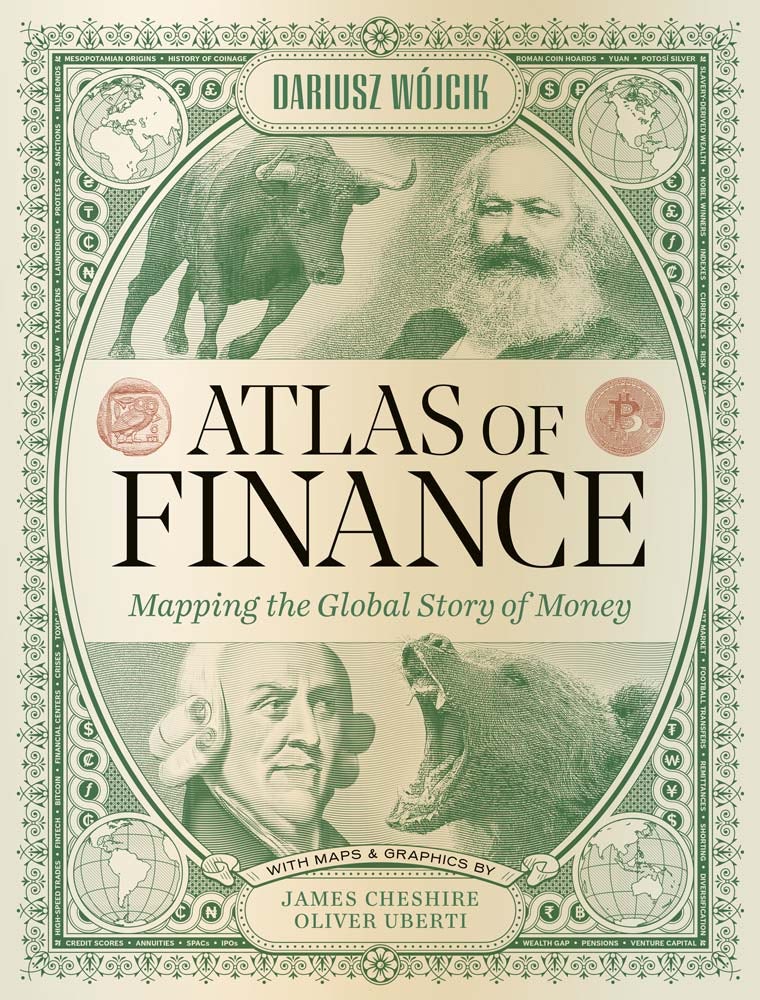Atlas of Finance: Mapping the Global Story of Money
October 2, 2024
Have you ever looked at a two-dollar bill in your wallet and wondered how many places and pockets it has travelled through? While this bill clearly represents a value of $2 today, it would have held no significance in 3000 BCE. The concept of value, as articulated by Seneca, “A thing is worth only what someone else will pay for it”, underpins Atlas of Finance: Mapping the Global Story of Money (Yale University Press, 2024), the first visually based book of maps and graphics dedicated to demystifying the world of finance. Authored by Professor Dariusz Wójcik (NUS Geography), Atlas of Finance offers a comprehensive exploration of global finance.
From the emergence of early monetary systems in the ancient world to today’s interconnected landscape of high-frequency trading and cryptocurrency, Atlas of Finance visually maps the evolution of global finance across history through four complementary lenses: assets and markets, investors and investments, intermediation and technology, and the geographical footprint of finance. It illuminates the complexities and paradoxes of finance, highlighting issues such as financial instability, bubbles, and crises, while also examining how regulation and governance can harness the power of finance for the greater good.
The first chapter, ‘History and Geography’, explores the historical and geographical evolution of finance, focusing on milestones that laid the foundations for modern financial systems. The ingenious creation of the cuneiform script by the Sumerians around 3000 BCE enabled the recording of transactions and the planning of city-states, facilitating complex social organisations that eventually evolved into today’s multi-trillion-dollar financial landscape.
The oldest surviving coins, made of electrum—an alloy of gold and silver—were recovered from Asia Minor (modern-day Eastern Türkiye). Coinage, crafted from various precious metals like silver, copper, nickel, and tin, spread through Greece, Rome, China, and India, transforming economies by standardising money and enhancing trade. Interestingly, Chinese currency evolved from commodities, such as silk and cowrie shells, to paper money as inflation soared from the excessive coin minting. At its peak, half a pound of salt was equivalent to one and a half pounds of iron coins. This culminated in a rebellion that led to the closure of mints, ultimately spurring the innovation of paper money. These early developments established the groundwork for today’s global financial system.
Following its examination of the foundations of modern financial systems, the chapter sheds light on how slavery-generated riches contributed to the establishment of institutions in Glasgow, including the municipal government and university. Understanding the origins of this wealth is a sobering reminder of the importance of acknowledging and addressing historical injustices. Prof Wójcik offers a comprehensive overview of how finance has been shaped by historical events and geographical contexts, highlighting both its advancements and its entanglements with exploitation and inequality.
Atlas of Finance stands as a testament to the dedication and expertise of its diverse team. Beyond its impressive scope, the book offers a first-of-its-kind approach that integrates geography, finance, economics, social sciences, and design, featuring visually stunning illustrations that transform complex financial topics into engaging and accessible narratives.
In future, the book will be translated into ten additional languages, including Mandarin. Learn more about and order Atlas of Finance at its official website, which includes an intricately animated and narrated book trailer!
A book launch will be held in Singapore at The Pod, NLB, on 24 October, and will include a book sale and signing. More details are available here.

